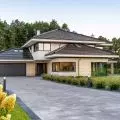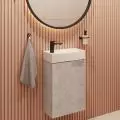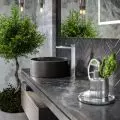How to design a house in a difficult space and at the same time satisfy investors. This was the challenge faced by Przemyslaw Kaczkowski and Magdalena Morelewska when designing Dom S.
Problems with Dom S began already with the plot - this one was not particularly large, compared to what the investors wanted. In addition, the local context was strongly imposed by the surrounding buildings, as well as the location of the access from the south. The challenge was to create a private space that would meet the family's requirements. In the end, these problems were solved, and in addition, the birch tree growing on the plot, whose crown shields the entrance to the building, was saved.
The project had to be integrated into a difficult, undersized plot of land
Photo: Piotr Krajewski | © Stoprocent Architekci
Przemysław Kaczkowski talks about the design process, the difficult plot, the use of modules and satisfaction
Wiktor Bochenek: You draw attention to the difficult space - how did you embed the S House in it?
Przemyslaw Kaczkowski (Stoprocent Architects): We wouldn't call it a "difficult space." A certain difficulty was the very realization in this space of a building that meets the clients' expectations. The plot they chose was quite far from ideal. The concept of an "ideal plot" for most of our clients is several, often conflicting expectations. For example, a north-south orientation with the entrance on the north side and the garden on the south, a site close to the center but without close neighbors, or a large area but not a large price. In this case, nothing matched up: the plot was not large, the entrance was on the south side and, in addition, the neighbor just beyond the fence.
Difficult to reconcile was the combination of garden and entrance from the south side
Photo by Piotr Krajewski | © Stoprocent Architekci
When embarking on the design of the S House, we were aware that the building should open up to sunlight, but at the same time provide users with intimacy from the street, that the living room and garden would (not very favorably) face the driveway and garage, and that the existing neighboring building strongly imposes its context. To solve this puzzle by design, we had to break with the common pattern: the front of the building maximally closed, and the garden elevations maximally open.
Wiktor: TheS House is based on compositional modules - on what principle were they designed?
Przemysław: This is true. Since the found context did not meet spatial expectations, we had to create one. We decided to build it from repetitive modules - analogous to how a child builds a house of blocks. To do this, we decided to operate a suitably smaller compositional module similar to the lump of the garage. Individual modules of the building, correspond to parts with different functions. They were functionally arranged at different levels in relation to the ground and in such a way as to create between them a small patio partially hidden from the street. In order to maintain in implementation this ideal concept of the impression of a building composed of freely stacked building blocks, it was necessary to use a number of complex technical solutions. Therefore, the building has a rather complex mixed construction: steel-reinforced concrete and brick. As is usually the case: achieving the effect of simplicity is very complicated.
The individual design of the ceramic facade, which was used in the implementation
Photo: Piotr Krajewski | © Stoprocent Architects
Wiktor: How did you create the division into open and closed spaces?
Przemysław: We wanted to maintain a delicate balance between the cubic and the "non-cubic", or void. Just as every representative edifice needs a square in front of the main entrance, the individual modules of the building need the free space of the garden. We also wanted the interior space to have its continuation outside the building. Thus, the patio with a terrace is a natural extension of the living room, the kitchen transitions to a shaded earth terrace to the north, and the rooms upstairs are connected to the terrace above the first floor. The house looks more spacious and larger than it actually is.
The house was designed taking into account the modules
Photo by Piotr Krajewski | © Stoprocent Architekci
Wiktor: We can notice a repeating ornament on the facade - why did you decide on this form of decoration?
Przemysław: In the initial assumptions, which we always write down before designing, we had a remark: "Modern architecture with a small touch of glamour". We thought for quite a long time how to realize this in practice. In the end, we decided on a customized pattern for the ceramic facade that is a distant reminiscence of the diamond division. The motif was repeated on the fence and in the drawing of the steel elements of the individually designed gate and gate. This was quite a breakneck task, because the division had to fit in with the divisions of the facade gate, be characterized by minimal slab dropout, and at the same time on the fence be fine enough so that the owners' dog would not sneak out of the garden.
Equally important was the space around the house
Photo by Piotr Krajewski | © Stoprocent Architects
Wiktor: How was your relationship with the investor?
Przemysław: Very well! This cooperation confirms our earlier observations that the best results are achieved when there is a desire for dialogue and mutual respect between the client and the architect. Every time we realize that the client places his trust in us, we feel an internal pressure not to let this trust down.
terrace from the south side
photo by Piotr Krajewski | © Stoprocent Architects
Wiktor: What caused you the greatest difficulty in this project, and what gave you the greatest satisfaction?
Przemysław: In retrospect, there is a great temptation to forget all the difficulties in the course and focus only on the pleasant satisfaction of the result. This, however, would not be true. Even a small project like this one requires a lot of energy and commitment for more than three years. Difficulties arise at every stage from conception to formal matters to implementation.
It was important to preserve the tall birch tree, which could have suffered during construction work
photo by Piotr Krajewski | © Stoprocent Architects
In the case of House S, for example, the design problem turned out to be the solution of the bathtub for washing the dog in the vicinity of the energy storage in the garage. Seriously. When designing for an individual client, we have to deal with a very broad spectrum of problems. Part of our job is to circumvent them, solve them or creatively disarm them. And in fact, the greater the difficulties, the greater the satisfaction of the result.
Victor: Thank you for the interview.
interior of the house
Photo by Piotr Krajewski | © Stoprocent Architects









































